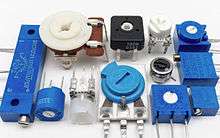Trimmer (electronics)


A trimmer[1] is a miniature adjustable electrical component. It is meant to be set correctly when installed in some device, and never seen or adjusted by the device's user. Trimmers can be variable resistors (potentiometers), variable capacitors, or trimmable inductors. They are common in precision circuitry like A/V components, and may need to be adjusted when the equipment is serviced. Trimpots are often used to initially calibrate equipment after manufacturing. Unlike many other variable controls, trimmers are mounted directly on circuit boards, turned with a small screwdriver and rated for many fewer adjustments over their lifetime. Trimmers like trimmable inductors and trimmable capacitors are usually found in superhet radio and television receivers, in the intermediate frequency (IF), oscillator and radio frequency (RF) circuits. They are adjusted into the right position during the alignment procedure of the receiver.
Trimmers come in a variety of sizes and levels of precision. For example, multi-turn trim potentiometers exist, in which it takes several turns of the adjustment screw to reach the end value. This allows for very high degrees of accuracy. Often they make use of a worm-gear (rotary track) or a leadscrew (linear track).[2]
In 1952, Marlan Bourns patented the world's first trimming potentiometer, trademarked "Trimpot", a name now commonly used to refer to any trimming potentiometer.
See also
References
- ↑ Variable Resistors; The Electronics Club.
- ↑ "Trimpot - Trimmer potentiometer". the Resistor Guide. Retrieved 20 February 2013.
External links
- Trimmer potentiometers (examples and internals), Robot Room